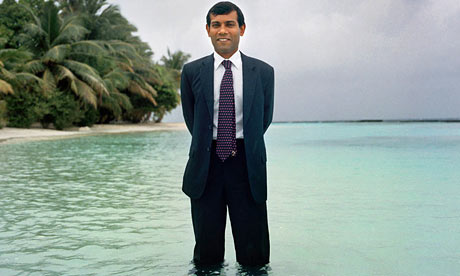Maldives announces windfarm plan to provide 40% of island's electricity
Plans for a new windfarm are set to make the Maldives the country with the highest proportion of renewable power in the world. The 30-turbine proposed windfarm, close to the capital Malé, will deliver 75 megawatts of electricity at full capacity, enough to provide electricity for the whole of the capital, the international airport and the surrounding resorts. Excess power will be used to run desalination plants that will produce bottled drinking water from the sea.
***
If built, the project will mean that per head of population, the Maldives will be getting about six times more electricity from wind than the UK. Mark Lynas, the British climate change expert who helped the Maldives develop its draft programme for carbon neutrality, welcomed the windfarm proposal, saying that it was an important signal to the rest of the world. "If a middle-income country can cut its emissions by a quarter through standard commercial partnerships, the rich world has little excuse for saying that carbon reductions are too expensive."
The Maldives government is taking the lead on climate change mitigation in an effort to push larger states into taking more determined action. Last month, President Mohamed Nasheed held a cabinet meeting under-water to highlight the plight of the low-lying island nation as the sea-level rises. In March, he announced a 10-year plan to reduce its use of fossil fuels to zero.
One part of this is a partnership announced in September with the British biochar company Carbon Gold to improve the country's soils by adding charcoal produced from coconut shells and other woody waste materials. The Japanese government is also giving $10m to provide solar panels to power schools and government buildings in Malé. And Nasheed will be hosting a planning meeting for a group of countries most vulnerable to climate change in the run-up to the UN climate change negotiations in Copenhagen in December.
The $200m windfarm project is being financed and built by Falcon Energy and will use turbines from the American company GE, one of the world leaders in wind energy. The project will start with a year-long analysis of wind conditions to assess the best arrangement for the turbines. It will then take up to two years to build. Hassan Zahir, chairman of the local electricity company, STELCO, said that the windfarm represented an important step in the country's move towards a carbon-neutral society.
A new gas turbine power station will provide back-up power when conditions are too calm for wind generation. The Maldives has moderate but reliable winds that blow for most of the year, making this source of power a good choice for the country.
Once built, the windfarm and the gas generator will replace old and inefficient diesel generators on which the Maldives has been completely reliant. The project is likely to provide about 40% of the country's electricity and reduce its overall carbon footprint by about a quarter. When completed, the windfarm should provide this small island state with the largest percentage of electricity sourced from renewable source of any country in the world. Another major windfarm announcement is expected within the next few months.
This article was originally published in the Guardian on Monday 2 November 2009.
